The camelids
Camelids are mammals that originated from North America. They disappeared from the North American continent as they spread to South America, Asia and Africa, where they survived to give rise to modern species.
Do you really know the difference between the four different camelids present in Peru?
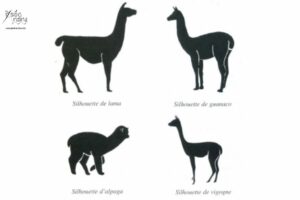
Se llama llama
¡Se llama llama! means his name is lama.
The llama is the animal most associated with Peru. It is the tallest of the four South American camelids, with an average height of 190 cm. As an adult, it weighs about 110 kilos.
It can be recognised by its slender silhouette, its extended legs and neck and its hair of different shades.
The llama was domesticated 4,500 years ago and lives mainly in Argentina, Bolivia, Chile, Ecuador, and Peru. It is used as a carrying animal and can carry up to 24 kg. It is also raised for its meat, leather, and wool. The latter is thick and is used to make ropes, carpets, etc. Llamas are shorn every two years and produce about 3.5 kg of wool per shearing. Their excrement is also used as fuel!
These animals live during the day and usually in herds of one dominant male, several females and their young. Llamas have a gestation period of about 11.5 months. These camelids are herbivores, i.e., they feed on grasses, which they chew for a long time in order to improve the digestion process. However, they drink very little. This is because they are very well adapted to their environment. In the dry season in the Andes, it never rains, and these camelids have become used to these extreme conditions! In addition, it has been observed that llamas have blood with a lot of haemoglobin, which allows them to adapt to the high altitudes, where there is less oxygen.

Alpacas, the sweetest of all!
In Peru you will also see many alpacas! They look like llamas but differ in their tail and floppy ears. They are only 150 cm long and weigh about 65 kg as adults. They have a round head and thick legs. They are also different because they have more wool than llamas. They are very gentle, calm, curious and intelligent animals. These animals are not used as pack animals because of their small size. They can live up to 5’000 meters above sea level and have a life span of 20 years. According to studies, the alpaca originates from the vicuna and has been domesticated by the Peruvians since pre-Hispanic times.
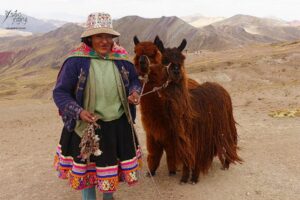
There are actually two types of alpacas in Peru. 12% of them are Suri alpacas. They are recognisable by their appearance, with their long, curly hair, which could be compared to dreads. The rest of the alpacas, over 80%, are Huacaya alpacas. These have a very good quality wool. The fibre is voluminous, fine, waterproof and three times more resistant than sheep’s wool. The alpacas are sheared by hand every two years.
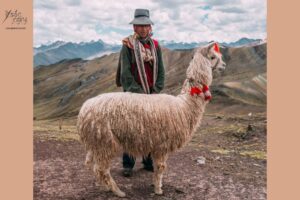
Peru is actually the world’s largest producer of alpaca wool. It is home to more than 87% of these camelids, which represents about four million animals. Alpacas are the main agricultural activity of many Peruvian communities, with more than 120,000 families involved in responsible farming. The animals live in the high Andean areas, in total harmony with nature. These families also carry out the spinning and production process. This process is also environmentally friendly as alpaca has a colour palette of up to 23 shades. It is therefore not necessary to dye the fibre! In Inca times, this fibre was so appreciated and prized that it was mainly used by the imperial class!
Let’s not forget that alpacas are also raised for their meat, including alpaca steak, served in many traditional restaurants!
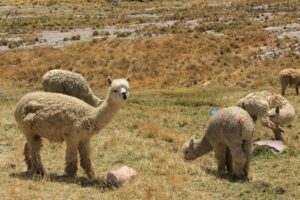
The vicuña, the Andean elegance
Vicuñas are the smallest camelids in the Andes, measuring between 120 and 180 cm and weighing around 40 kg. Vicuñas are wild and live between 3’500 and 5’500 m. above sea level.
As far as their appearance is concerned, we can say that they have a deer-like appearance. They have long, thin legs with pads on the ends, which allows them to walk on different types of grounds. Vicuñas have a cinnamon-coloured coat on their backs and a white coat on their bellies, as well as a white tuft of hair on their chest. In general, this animal is said to be very graceful, despite its shy character. Vicuña fibre is finer than silk and is said to be one of the finest and most expensive in the world, costing around 400€ per kilo. Because the vicuña’s coat is very short, about 3 cm, only 320 g of fibre are harvested per shearing and per animal.
The shearing of this protected animal is also a very important topic, an ancient and sustainable shearing technique called chaccu is used. The aim is to gather the vicuñas without stressing them. To do this, a group of people hold ropes with coloured ribbons to build a kind of barrier. The capture is risky because vicuñas are very sensitive to stress and fear. Indeed, it has been proven that if the vicuñas suffer, the quality of the fibre deteriorates, births decrease, and mortality can increase during and after shearing. In reality, only certain communities on the Altiplano are allowed to gather vicuñas for shearing, while respecting the basic principles of chaccu. Shearing should only be carried out in the spring, as the weather conditions are most favourable at that time. Afterwards, the profits from the sale of the wool go to the communities close to the areas where the vicuñas live.
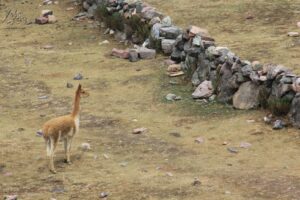
Because of the quality of their wool, vicuñas were hunted by the Spanish in 1532. They were victims of poaching: their fur was sold illegally! By 1965, the vicuñas had almost disappeared, so in 1976 a law was passed banning their hunting in order to protect the species. Today, there are more than 20,000 vicuñas in Peru, compared to less than 5,000 in 1965.
In 1976, the Pampa Galeras National Reserve was created in the province of Lucanas, 98 km from the city of Ayacucho. This reserve is home to thousands of vicuñas, as well as other Andean species such as the Andean fox. The aim of creating this protected area was to achieve sustainable conservation of the vicuña. The reserve also hosts the Chaccu Nacional de la Vicuña festival in June, which in Quechua means “capture of vicuñas”.
Vicuñas live in the Peruvian and Bolivian highlands, as well as in Ecuador, northern Chile and northwestern Argentina. They are generally organised into two distinct territories: a feeding area and a resting area. Vicuñas live in herds, usually consisting of a dominant male, females and young. From the age of 12 to 18 months, the young become independent and are forced out of the herd by the dominant male. They will then have to create a new harem in their turn. Vicuñas have a life expectancy of 20 years, and their main predators are Andean foxes, pumas, and condors.
The vicuña is on the national emblem of Peru, so it is a real national symbol in the country! Peru wanted to include elements representing the natural wealth of Peru in the national emblem. The vicuña, famous throughout the world for its fine wool, represents Peru perfectly. In addition, since 2021, the vicuña has appeared on the new ten soles banknotes.
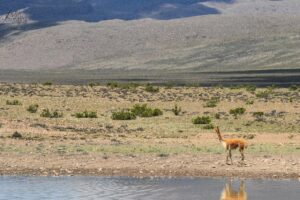
The guanaco, the least popular of all
And finally, the last camelid, the guanaco. This one is also wild and protected, like the vicuña. It lives at an altitude of more than 3,000 metres, in cold, dry, and arid regions. This corresponds mainly to Patagonia, but also to the entire Andes mountain range. Very little present in Peru, we unfortunately do not have any pictures of guanaco for you. But it could look like this!
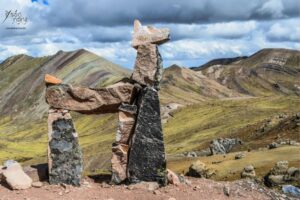
The guanaco is smaller than the llama but larger than the vicuna. As an adult, it is about 180 cm long and weighs 140 kg. They have a slender build; a rough coat and their wool is not appreciated. They are generally reddish brown but uniform in colour, with a blackish grey muzzle and ears and white belly or legs. This animal lives in small groups of 20 individuals, usually led by a dominant male. They are known for their speed, reaching a top speed of 56 kilometres per hour!
So, do you all know how to recognise them? See you in Peru for a real time quiz!
Sources:
http://www.voyage-tourisme-au-perou.com/les-camelides-andins-lamas-alpaga-vigogne-guanaco/
Livre « Ausangate », édité par l’association « Ruta Turistica Ausangate », https://rutaausangate.com/
https://peru.info/es-pe/turismo/noticias/3/16/sorprendete-con-la-flora-y-fauna-de-pampa-galeras
https://www.jacadatravel.com/the-explorer/meet-camelids-llama-alpaca-vicuna-guanaco/

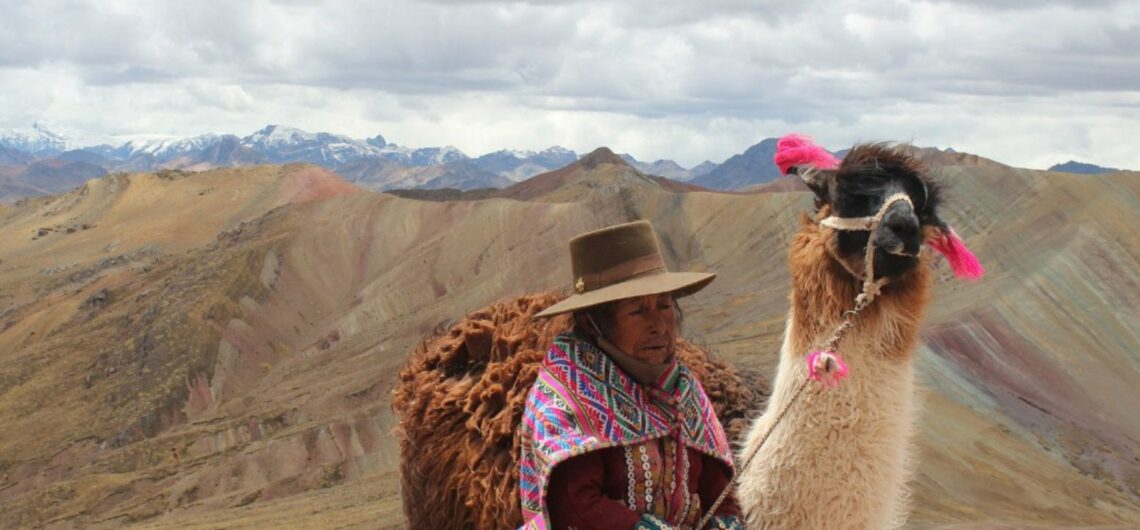
Comments